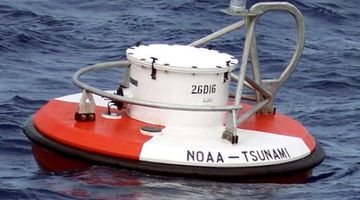This interactive looks at the electromagnetic spectrum. To use this interactive, move your mouse or finger over any of the labelled boxes and select to obtain more information.
Select here for a transcript and copyright information.

The electromagnetic spectrum is a classification of the Sun’s radiation. Scientists have identified solar energy as a spectrum of many different wavelengths of electromagnetic rays. They have called this the electromagnetic spectrum.
Click on each wavelength to learn more about the waves that make up the spectrum.
Transcript
Radio
Radio waves have the longest wavelengths in the electromagnetic spectrum. They are used to transport information through the atmosphere without wires. They carry signals to your radio, television and mobile phone.
Astronomers like Melanie Johnston-Hollitt use radio telescopes that receive radio waves emitted by planets, stars, galaxies, and nebulas to study the far reaches of the universe.
Image acknowledgement: Galaxies show as small radio emissions in this telescopic image by Melanie Johnston-Hollitt
Microwave
Microwaves have wavelengths that can be measured in centimetres. Microwaves are widely used in modern technology. They are used for diverse applications like heating food in a microwave oven, garage door openers, particle accelerators and for transmitting information from one place to another. Shorter microwaves can be used for radar, like the Doppler radar used in weather forecasts.
Image acknowledgement: Andriy Popov, 123RF Ltd
Infrared
Infrared light has a range of wavelengths. ‘Near infrared’ has shorter wavelengths and is used for devices such as night vision goggles. ‘Far infrared’ has longer wavelengths and is used for things such as thermal imaging. In the thermal image above the left hand cup holds a hot drink and the right hand cup a cold drink. The coolest parts are dark blue and the hottest parts have been coloured white to signal a temperature of 55° Celsuis and beyond.
Infrared can also be used for some short range ‘line of sight’ communication, such as TV remote controls.
Image acknowledgement: University of Waikato
Visible light
Visible light waves are the only electromagnetic waves we can see. We see these waves as the colours of the rainbow. Each colour has a different wavelength. Red has the longest wavelength, and violet has the shortest wavelength. When all the waves are seen together, they make white light.
Image acknowledgement: Delcreations, 123RF Ltd
Ultraviolet
There are several regions to ultraviolet light in the electromagnetic spectrum, ranging in wavelength between 10 and 400 nanometres. Too much exposure to UV light (such as that emitted from our Sun) can cause harmful effects like sunburn. However, ultraviolet light has been used for things such as UV lasers, fluorescent lamps and disinfecting wastewater.
Image acknowledgement: University of Waikato
X-ray
X-rays have one of the smallest wavelengths in the electromagnetic spectrum. They have higher energy than ultraviolet light, but longer wavelengths than gamma rays. X-rays are primarily used for diagnostic radiography. They are formed through ionizing radiation, and too much exposure (the radiation is too intense and/or you are exposed for too long) can be dangerous.
Image acknowledgement: University of Waikato
Gamma
Gamma rays have the smallest wavelengths in the electromagnetic spectrum. They have the most energy of any wave. The waves are generated by radioactive processes such as in nuclear explosions. Like other areas of the electromagnetic spectrum, they can be used to kill living cells, such as cancer, but can provoke DNA alteration by interfering with the genetic material of the cell.
Image acknowledgement: A nuclear test conducted by the United States in 1953 in the Nevada Desert. Public domain.







